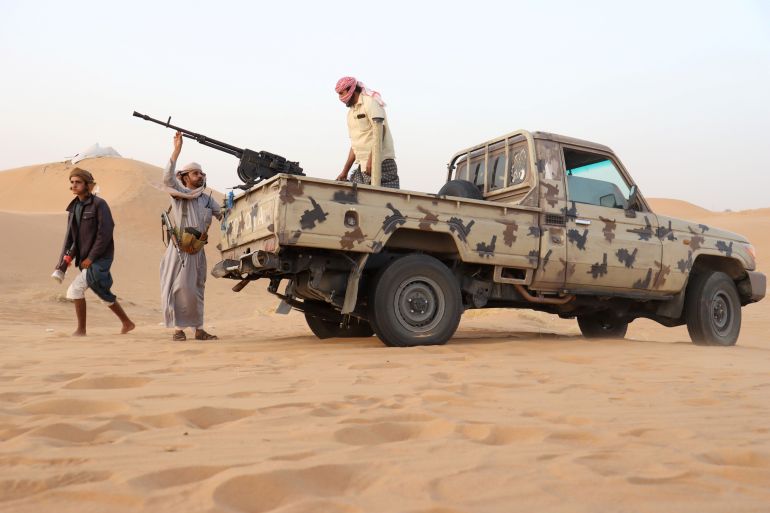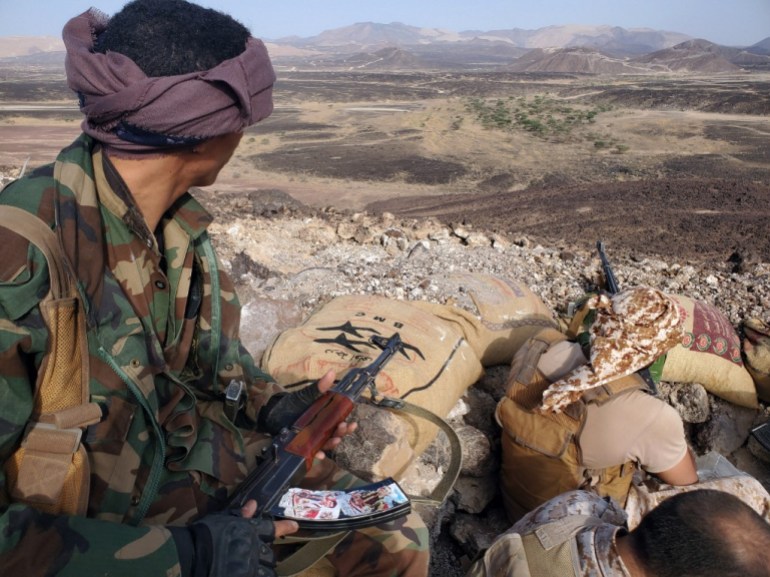Yemeni government forces again on the backfoot
After a number of setbacks, the Houthis recaptured Rahabah district and are now threatening to gain control over Marib, the last gov’t stronghold.

Thousands of civilians have been displaced in Yemen’s Marib after a Houthi offensive that began at the start of September saw the rebel group take control of a key district in the south of the governorate.
Rahabah, which lies to the east of the Houthi-held capital Sanaa, was captured on September 8 after heavy fighting that led to at least 65 fighters’ death on both sides.
Keep reading
list of 4 itemsIn Pictures: The grim battle for key Yemeni city of Marib
Yemen currency clash deepens crisis in war-torn country
Millions ‘one step away’ from famine in Yemen, UN warns
“The internally displaced people are suffering,” Mahdi Balgaith, an analyst at the Sanaa Center for Strategic Studies, told Al Jazeera.
“Many of the families have been forced to live out in the open without proper shelter in terrible conditions; they lack the most basic needs, such as shelter, food, water, and educational facilities,” Balgaith, who is based in Marib, added.
Rahabah had been a bright spark for government forces in a year that has been punctuated by military setbacks. However, the Houthi capture marks their latest reversal.
The district had come back into government hands in July after having been initially lost in a Houthi advance in September 2020. The Houthis also continue to threaten the government’s last major stronghold in northern Yemen, Marib city, further highlighting the importance of establishing some forward momentum after the July capture of Rahabah.
Instead, government forces are again on the backfoot, and problems that have plagued them for the last two years have reoccurred.
“Government forces in Rahabah, along with their allies, were unorganised,” said Balgaith. “The main tribes fighting with the government forces in Rahabah received limited support, while the Houthi forces were organised and well-supported.”
False dawns
The reversal in Rahabah is the latest in a worrying trend for the Yemeni government’s military.
So far in 2021, along with Marib, government forces have launched offensives in Bayda in central Yemen, Taiz in the southwest of the country, and Hajjah in the northwest. While they all brought about initial successes, particularly in Taiz, and much fanfare from pro-government media, none has had much of a lasting effect, and most government advances have eventually been reversed by the Houthis.
In fact, in some areas, the Houthis now find themselves in an even better position than before the government forces’ offensives. For example, in mid-July, the Houthis recaptured areas they lost to a government offensive two weeks earlier, before continuing on and capturing long-held government-controlled areas in the governorate.
The newly acquired territory has allowed Houthi forces to move the fighting to the border between Bayda and the government-controlled, and resource-rich, Shabwah governorate.
“There is no government military strategy,” Maysaa Shuja al-Deen, a Yemeni researcher, told Al Jazeera. “These government offensives are usually an attempt to increase activity on a front line, alleviate popular discontent, or get more funding.
“No decision has been taken to push for victory, that is very clear. Instead, most offensives are merely aimed at presenting an image to the media, and lifting the morale of the troops,” Shuja al-Deen added.

Looking for a way out
Morale has been low on the government side with salaries often going unpaid, and the Houthis on the front foot militarily for the past two years. Saudi Arabia, the Yemeni government’s main backer, appears to be looking for a way out of the conflict, which has caused what the UN calls the world’s worst humanitarian crisis.
The anti-Houthi side is also riven with divisions with government forces, southern separatists, and loyalists of ex-President Ali Abdullah Saleh’s nephew, Tariq, all ostensibly on the same side, but in reality opposed to each other.
“The government would need to completely change its leadership in order to change its military performance,” said Shuja al-Deen. “The leadership, led by President Abd-Rabbu Mansour Hadi, was part of Saleh’s corrupt system. He is a man who was the silent vice president between 1994 and 2011, and is used to doing nothing.”
Meanwhile, government forces and the wider anti-Houthi coalition-backed side continue to be vulnerable. On August 29, at least 30 coalition-backed soldiers were killed in a Houthi attack on the country’s largest military base, al-Anad, in the southern governorate of Lahj. On September 11, the Houthis fired missiles and drones at al-Makha port, on Yemen’s Red Sea coast.
With government forces so far incapable of reversing the Houthi tide, and the Saudi Arabia-led coalition apparently unwilling to extend itself further in Yemen, the Houthis continue to appear on top. While that may not mean an end to the war anytime soon, it is a position the Houthis, secure in the capital Sanaa, are comfortable with.
“The Houthis do not need to control the whole country to win, just the areas they currently control, where most of the Yemeni population live,” said Shuja al-Deen. “Can they do more? Possibly. But a total victory would be difficult, and the country would prove impossible to govern.”